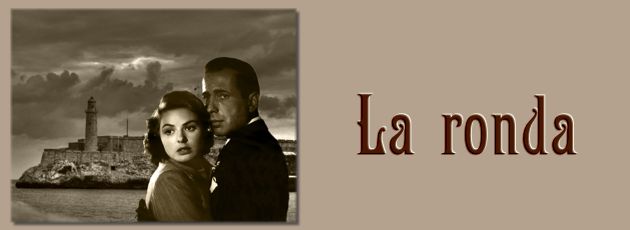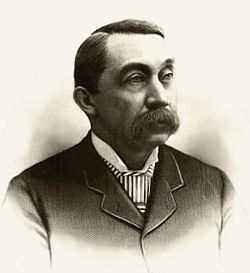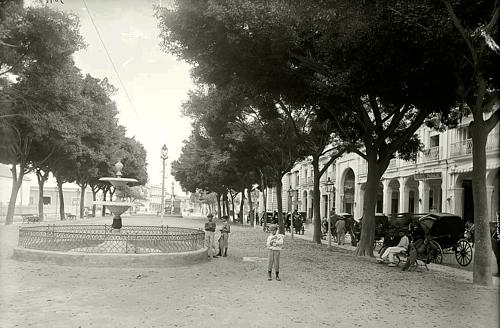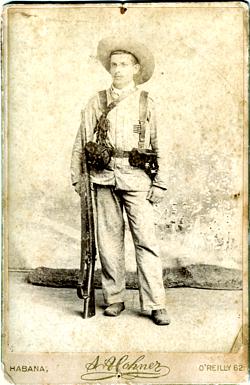
 Impressions of Havana
Impressions of Havana
Extracts from the Diary of a Physician, Dr. E. M. Hale, of this City
A Delightful Clime, with Fruits of All Kinds in Great Abundance
Street Scenes – The Soldiery – A Bill of Fare – Smoking Universal – The Toledo
Part First
April 19. --- We steamed into the harbor of Havana, under the walls of Morro Castle, once a really formidable defense, now it would be unable to withstand the shot and shell of an English iron-clad; but it is an interesting fort, with its high towers and grim foundations of the primeval rock, in which we are told are excavated deep and gloomy dungeons for political criminals. The harbor presented a beautiful appearance. It is really one of the finest in the world. It was crowded with shipping, from the quaint, half-covered boats called “Faloa” to the great Spanish and English merchant vessels. After running the gauntlet of Custom House officials we were taken to the Hotel Pasaje, one of the best and most commodious hotels in Havana.
I propose to give my impressions of Cuban diet, and I will simply begin by saying I was happily disappointed. We went in to breakfast at 10. On the card the menu was printed in English and Spanish. We had delicious French bread, fried sardines, caught fresh from the bay – delicious – a little fish, fried in batter, fried plantains, like sweet potato, only sweeter. Here I got the first good cup of tea since I left home in Enterprise – Souchong, dark as coffee, of
breakfast at 10. On the card the menu was printed in English and Spanish. We had delicious French bread, fried sardines, caught fresh from the bay – delicious – a little fish, fried in batter, fried plantains, like sweet potato, only sweeter. Here I got the first good cup of tea since I left home in Enterprise – Souchong, dark as coffee, of
HEAVY BODY AND FINE FLAVOR,
such as I used to get in England. After breakfast we got rooms, two fronting the Prado, a wide, shady street, the trees in the center, a species of laurel, the promenade between. Sitting-rooms with a large rug in the middle with the eternal two rows of rocking-chairs, the rooms high and airy, no glass in windows, lattice outside, heavy shutters inside. The roar of the street like that of State and Monroe, at the Palmer House. Coming from the harbor we were driven through narrow streets, whose appearance transported you back to old Spain. Indeed, I am told that in many things Cuba is more Spanish than Spain.
To one who has never been in Spain the street sights are novel and often astounding. After breakfast I took a walk down the Prado. The first sight was the Cuban milk-wagon – not a wagon at all, but a mule, on whose back was a pillion two feet high, built up of straw and leather; on the top a boy, and hanging on all sides of him the numerous milk cans. The cow with a calf is driven to the entrance of the house, milked the amount wanted. This method is for children and invalids. The calves have on a wire muzzle.
Next I came upon a fruit stand, and none in the North can compare with them, for
THE MAJORITY OF CUBAN FRUITS
are so perishable when ripe that they ca not be conveyed off the island. The pineapple, which we never get ripe, is here like a massive ruby, whose interior you can eat with a spoon. In this condition it is the queen of all fruits. The mango, looking something like a kidney-shaped pear, green rind, spotted with red. Peel this off and around a stone filling three-quarters its interior is the yellow pulp, reminding one of the pineapple and the peach. The sapodilla, a brown-skinned, round fruit, the size of a peach, and tasting like a very, very insipid pear. The  Maumee apple is like a small brown melon, the interior a vivid flesh color. Then there are watermelons, muskmelons, plantains, bananas, and many others whose names I could ascertain to-day.
Maumee apple is like a small brown melon, the interior a vivid flesh color. Then there are watermelons, muskmelons, plantains, bananas, and many others whose names I could ascertain to-day.
I have often prescribed the tamarind to my patients. Here I got the fruit, like a large bean in the pod, soft acid, and fresh, prepared in water, and tasted for the first time this delicious drink in its natural state.
More of fruits anon.
The street are so narrow that carriages can barely pass. The sidewalks rarely three feet, oftener only twenty inches or two feet wide. You have to step into the gutter or flatten yourself against the wall to let one pass.
THE SHOPS OF ALL KINDS
open right on this narrow walk, so do the windows of residences, with iron bars and wooden shutters. Large residences or apartment houses are built around an inner court, where is a garden filled with flowers and a fountain. The rooms open on open balconies, which overlook the court. The main entrance is contrary to all our ideas. You enter a passage on the street in which the family carriage usually stands. A cigarette maker usually sits just inside with piles of cigarettes fresh made. It is like entering one’s residence through the carriage-house.
The public vehicles on the street are many – the victoria is the usual public conveyance; no hansoms or gurneys or coupes here yet. Occasionally a wretched-looking omnibus – or worse street car. Saw a few elegant private carriages, fines victorias, or coupelets with excellent teams.
The great, hig-wheeled carts, drawn by oxen, with the bow fastened to the horns, a frame lashed to the forehead, fixing the head immovable; seems an inhuman method. If the cart is loaded heavily, every movement on the rough pavement imparts a jerking motion to the head, which must be painful. When the vehicle is four-wheeled this is obviated. For lighter loads the cart is drawn by one,
jerking motion to the head, which must be painful. When the vehicle is four-wheeled this is obviated. For lighter loads the cart is drawn by one,
OR EVEN EIGHT MULES,
in single files. The mules must have a very heavy harness, great headstalls, ornamented with huge red tassels, one on each side, with the fruits mentioned above; also stalks of sugar cane, which takes the place of candy for juvenile Cubans. Garden vegetables are brought to market and carried around the streets in the same manner.
April 20. --- I do not find it uncomfortably warm – thermometer at noon 78 degrees. A cool refreshing breeze from the sea. In the evening, went to Park Isabella to hear the military band, but it didn’t play. It is a lovely park, occupies one square, brilliantly lighted, broad walks, beds of gorgeous flowers and plants, mostly cacti.
Dinner – Soup, rice, fish – all colored yellow with powdered saffron; meats cooked very “done.” Dessert – Pine apples, sapadillo and “creame,” a kind of custard.
Streets thronged in the evening, but no ladies, except American and English, and a few nondescripts. The omnipotent lottery venders plague one continually. One of the greatest curses of Cuba – the lotteries.
SAW TWO CHARACTERISTIC CUBAN SCENES
 to-day. In a little shop where whip and halters, brushes and other adjuncts were made, nearly all from a kind of grass or fibre of some plant. Three men were sitting around a small charcoal table on which was a kettle on a charcoal fire. Each dipped out his share of the soup or stew, and ate it with a bid of hard Spanish bread. All of this in a little room not six feet square, opening directly on the street.
to-day. In a little shop where whip and halters, brushes and other adjuncts were made, nearly all from a kind of grass or fibre of some plant. Three men were sitting around a small charcoal table on which was a kettle on a charcoal fire. Each dipped out his share of the soup or stew, and ate it with a bid of hard Spanish bread. All of this in a little room not six feet square, opening directly on the street.
Another, a group of soldiers drinking azucarilla around a table on the sidewalk. This drink is made by dissolving what appears like cakes of solid foam in ice water, and sipping it through a straw. The foam is white of egg and sugar beaten together until it is very thick – almost solid – and then cut into cakes. On every drinking counter it can be seen heaped in great pyramids.
We hear of priest-ridden lands, but this is certainly a soldier-ridden one. They fairly swarm. You see them at every street corner – they throng the Prado – the parks are full of them. At the door of every public official there is a sentinel pacing to and fro. And the oddest uniforms. One kind wears blue jeans, or what looks like it, a thru, mix cotton goods, with red trimmings. Another dark-blue with the
RED AND GOLD COLORS OF SPAIN.
I have counted six different kinds. You can not tell them from the police. In fact, they are the police, for the city of Havana knows no municipal government like ours. Everything is under military rule. I hear, however, the night police, not having being paid for eighteen months, have struck – gone off duty. They could not have been part of the military. This places the city in a dangerous state after 12 o’clock, the usual bedtime of the Cuban.
…………………………………………………
Smoking is as near universal as possible. Men, women, and children smoke. The black women, great, long cigars; some Cuban ladies, small, delicate cigarettes.
……………………………………………

Chicago
The Daily Inter-Ocean, Saturday Morning, May 22, 1886, p. 10
Edwin Moses Hale, physician, born in Newport, New Hampshire, 2 February, 1829. He became a printer in early life, employing his leisure hours in study. He was graduated at the Cleveland homoeopathic medical college in 1859, practised his profession for twelve years in Jonesville, Michigan, became in 1863 professor of materia medica and therapeutics in the Hahnemann medical college, Chicago, and held the same chair in Chicago homoeopathic college from 1880 till 1884, when he became professor emeritus. In 1871 he began a series of special lectures on diseases of the heart. In addition to his editorial connection with various journals he is the author of many monographs and of several treatises, among which are New Remedies (2 vols., New York, 1867); Pocket Manual of Domestic Practice (1870); Lectures on Diseases of the Heart (1871); and Diseases of Women (1875).

